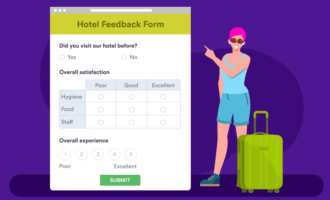5 different questionnaire types
- Closed-ended questions
- Open-ended questions
- Multiple-choice questions
- Dropdown selection questions
- Likert scale questions
Understanding your audience is key to making the best decisions for your organization. A well-designed questionnaire can help you do just that.
In this article, we’ll discuss five main types of questionnaires and when to use them.
The function of questionnaires
A questionnaire is a list of questions posed to a group of respondents to collect information about their preferences, experiences, attitudes, and opinions. Organizations often use questionnaires for market research. They then analyze questionnaire responses to inform their decision-making.
Questionnaires can use open-ended questions, closed-ended questions, or both. Closed-ended questions give respondents a fixed set of answer choices. They collect what’s known as quantitative data. Open-ended questions, on the other hand, allow respondents to provide their opinions in their own words. This is known as qualitative data.
Qualitative research usually answers “how” and “why” questions. Quantitative research emphasizes statistical analysis.
(A quick note about the difference between questionnaires and surveys: A questionnaire is a specific data-collection tool used within an overall survey. A survey is the overarching research method that may also include interviews, focus groups, and other research techniques.)
The importance of questionnaires in research, feedback gathering, and data analysis
A questionnaire can gather valuable feedback from customers, employees, or other stakeholders. You can then analyze that data to help you make business improvements.
By providing actionable insights into customer preferences, questionnaires can help your business develop products, identify trends, improve customer service, and more. They provide companies with a fast, effective, and relatively low-cost way to gather large amounts of quantitative and qualitative data to improve decision-making.
5 types of questionnaires
You can employ the following types of questions to get insights into your audience and improve business operations:
- Closed-ended questions
- Open-ended questions
- Multiple-choice questions
- Dropdown selection questions
- Likert scale questions
Here’s a breakdown of how and when to use each.
1. Closed-ended questions
Closed-ended questions allow respondents to select a single option from among a given set of choices. They provide standardized data for easy analysis, making them beneficial for quantitative research.
Types of closed-ended questions include multiple-choice, rating scale, and dichotomous questions. We’ll focus on multiple-choice questions as a separate questionnaire category below.
Rating scale questions show respondents a numbered scale, such as 0–10. Respondents choose a number on the scale that most closely reflects their opinion. For example, you could ask how likely users would be to recommend a product to others, with 0 being not likely and 10 being extremely likely.
Dichotomous questions have only two possible answers, such as yes/no, true/false, or agree/disagree.
A close-ended question example in the Support Satisfaction Survey
2. Open-ended questions
Open-ended questions allow respondents to answer in their own words. Instead of choosing from a set of responses, respondents share their opinions in long- or short-form narratives. This results in more in-depth responses, richer data, and detailed qualitative insights.
These kinds of questions work well when you’re looking for context and in-depth insights, or if you have a small group of respondents.
An open-ended question example in the Employee Favorites Questionnaire
3. Multiple-choice questions
In multiple-choice questions, respondents select an answer from a list of provided options. The responses offered are often presented as either radio buttons or checkboxes. Multiple-choice questions are easy to answer, which often results in higher questionnaire completion rates. They’re also easier to review, allowing you to gather immediate insights.
One example of this type of questionnaire is a quiz. Creating one with Jotform’s free online quiz maker is a breeze. It allows you to create interactive, multiple-choice quizzes, with no coding required.
A multiple-choice question example in the Software Survey Form
4. Dropdown selection questions
Dropdown selection questions are similar to multiple-choice questions. Respondents may only select one of the provided answers. In this case, a dropdown menu displays a selection of answers to choose from.
Jotform’s free Dynamic Dropdown widget adds a dropdown menu that changes according to a respondent’s previous answers. Because respondents don’t have to scroll through options that don’t apply to them, they can choose the appropriate response more quickly and easily. Dropdown selection questions are ideal for service request forms, booking forms, evaluation forms, applications, and more.
A dropdown selection question example using the Dynamic Dropdown widget
5. Likert scale questions
Likert scale questions allow respondents to share their level of agreement with a statement using a numerical scale. A Likert rating scale is useful for measuring opinions, attitudes, and knowledge. For example, you could ask users to rate how satisfied they are with your product or service on a scale of 1 to 5, with 5 being very satisfied. Responses to Likert scale questions are easy to organize and interpret.
Jotform’s free Likert Scale Creator allows you to build Likert scale surveys and questionnaires. You’ll have the ability to collect feedback or research data and add a Likert scale rating to any online form.
A likert scale question example in the Job Satisfaction Survey
What to consider when choosing a questionnaire type
When choosing a questionnaire type, consider your research objective, target demographic, and available resources.
If you’re just getting started and still forming a hypothesis, open-ended questions will be the most beneficial. If you’re at the stage where you’ve already done that and you’re trying to prove or disprove a hypothesis, then a closed-ended questionnaire would likely be more effective.
Say you’re testing to find out whether to add a specific product to your product suite. You’d ask respondents about similar products they’ve bought in the past. But if you’ve already created a new product and want to determine market response, that question won’t be helpful.
You may also want to segment your audience to select the right questionnaire type for each segment. For example, if you’re asking questions about pricing, segment customers according to their current pricing tier. In this case, you might consider open-ended questions to gather feedback on a planned price increase that adds new features.
When it comes to available resources, ask yourself these questions:
- Do you have a large number of customers to survey about a proposed product or service improvement?
- If so, do you have a customer database that provides easy access to contact info, such as email addresses?
- Is this a new offering where you hope to reach an entirely new target market?
- If so, how and where will you engage with them?
- Will you buy ads to draw people to your questionnaire? If so, what incentives do you plan to offer to get them to complete it?
Resources for creating surveys and questionnaires
Creating engaging surveys and questionnaires is easy with Jotform. Build your own survey from scratch or use one of our premade survey templates and customize it to match your specific goals.
You can also check out our ready-to-use questionnaire templates, created for a variety of use cases. Simply customize your online questionnaire with our drag-and-drop form builder, and you’ll be ready to go.
We also offer fully customizable templates for employee satisfaction surveys and product surveys. These tools make it simple to share, collect, and analyze your survey results.
And finally, try our free online survey maker. Whether you’re conducting research or gathering feedback, you can use this tool to create engaging online surveys. Drag and drop your questions, set up conditional logic, and share your custom survey online to start collecting responses.
No matter what your goal is for gathering audience data, a well-designed questionnaire can help you achieve it. Use questionnaires to improve customer service, launch new products, conduct in-depth market research, and more.
Photo by Christina Morillo







































































































Send Comment: